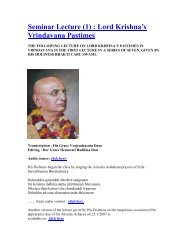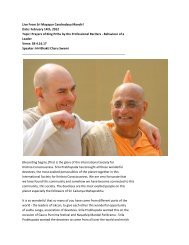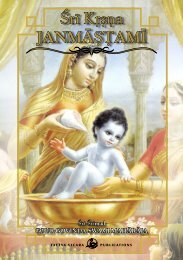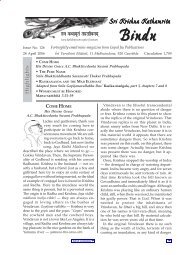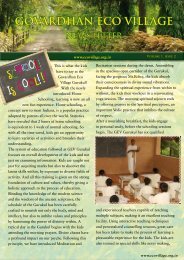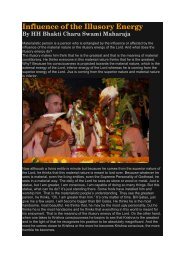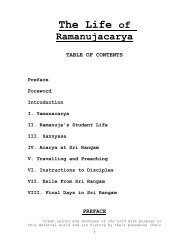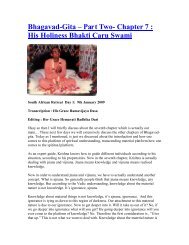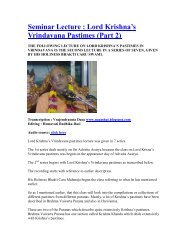How to teach sanskrit and music - ebooks - ISKCON desire tree
How to teach sanskrit and music - ebooks - ISKCON desire tree
How to teach sanskrit and music - ebooks - ISKCON desire tree
Create successful ePaper yourself
Turn your PDF publications into a flip-book with our unique Google optimized e-Paper software.
HOW TO TEACH SANSKRIT, MUSIC AND ROTE IN HOME<br />
SCHOOLING<br />
by Aruddha Devi Dasi<br />
Srila Prabhupada wanted our children <strong>to</strong> learn English <strong>and</strong> Sanskrit so that they could study<br />
his books deeply. In a Srimad Bhagavatam lecture in 1974 he said:<br />
"Our students specifically, they should take care of reading Srimad-Bhagavatam. We have<br />
therefore prescribed in our school, Dallas, that let them simply learn Sanskrit <strong>and</strong> English,<br />
because English translation they will be able <strong>to</strong> read, <strong>and</strong> the Sanskrit verses are there. And<br />
from the very beginning, if they begin education with Bhagavad-gita <strong>and</strong> then comes <strong>to</strong><br />
Srimad-Bhägavatam <strong>and</strong> reads the whole literature, then they will be more than M.A., Ph.D.<br />
More than. The knowledge will be so advanced.”<br />
Srila Prabhupada did not want the children <strong>to</strong> study Sanskrit simply <strong>to</strong> become grammarians<br />
or scholars. Rather he wanted them <strong>to</strong> learn Sanskrit <strong>and</strong> English so that they could read his<br />
books deeply <strong>and</strong> <strong>teach</strong> them <strong>to</strong> others. “Our aim is not how <strong>to</strong> make the students a big<br />
grammarian. No. That is not our purpose. <strong>How</strong> <strong>to</strong> make him fully Krsna conscious. That is the<br />
aim of this gurukula." He asked that every Sanskrit class begin <strong>and</strong> end with kirtana.<br />
Often when devotees approached Srila Prabhupada with the <strong>desire</strong> <strong>to</strong> learn Sanskrit, he<br />
engaged them in preaching instead. He cautioned them that little knowledge is a dangerous<br />
thing—we can become proud <strong>and</strong> lose our focus on devotional service. To learn Sanskrit<br />
properly, one has <strong>to</strong> study grammar diligently for at least 12 years.<br />
But Srila Prabhupada encouraged Sanskrit as a subject in the gurukula, since children can be<br />
properly trained in the language from an early age. In this way, they can underst<strong>and</strong> the<br />
meaning of the scriptures more deeply <strong>and</strong> use that knowledge in practicing <strong>and</strong> preaching<br />
Krsna consciousness. He said that when we study the Sanskrit verses, in each word we will<br />
find a treasure house of meaning.<br />
A good example was set by Lord Caitanya when he opened his Sanskrit school in Navadvipa<br />
at the age of sixteen. In this school, He would simply explain Krsna, even in readings of<br />
grammar. Later, Srila Jiva Gosvami, in order <strong>to</strong> please the Lord, composed a Sanskrit<br />
grammar book called Hari-namamrta-vyakarana in which all the rules of grammar were<br />
composed with holy names of the Lord. Thus, anyone who learned the rules would be reciting<br />
the names of Krsna <strong>and</strong> in this way receive immense spiritual benefit.<br />
Srila Prabhupada emphasized that children should attend the morning Bhagavatam class every<br />
day along with the elders <strong>and</strong> recite the Sanskrit verse, word meanings, translation <strong>and</strong><br />
purport. Then they should discuss all the points in the verse. “So read Bhagavatam, pronounce<br />
the verses very nicely. Therefore we’re repeating. You hear the records <strong>and</strong> try <strong>to</strong> repeat.<br />
Simply by chanting the mantra, you’ll be purified. One who is chanting this verse, <strong>and</strong> one<br />
who is hearing this verse, he is becoming pious au<strong>to</strong>matically. Pious. To become pious one<br />
has <strong>to</strong> endeavor so much, do this, do that, but if you simply hear these verses of Srimad-<br />
Bhagavatam, Bhagavad-gita.”<br />
Srila Prabhupada said the Sanskrit verses in his books are meant for our underst<strong>and</strong>ing <strong>and</strong><br />
memorization. We repeat the verses again <strong>and</strong> again so that we can memorize <strong>and</strong> recall them<br />
when there is a need. He said that every word in Sanskrit literature has a particular meaning,<br />
particular thought. Therefore, the language is called Sanskrta, refined <strong>and</strong> purified.<br />
<strong>How</strong> <strong>to</strong> Teach Sanskrit<br />
The best way <strong>to</strong> learn Sanskrit is <strong>to</strong> find a local devotee who can <strong>teach</strong> your children on a<br />
regular basis. In Boise, we were fortunate <strong>to</strong> have a Sanskrit <strong>teach</strong>er, Gary Thomas, who is a<br />
self-taught Sanskritist. In fact, he is an expert linguist <strong>and</strong> knows more than 10 languages. He<br />
1
diligently taught my sons once a week for several years. He always made it fun <strong>and</strong><br />
challenging <strong>and</strong> sometimes they would be absorbed for two or three hours. He used<br />
Kusakratha Prabhu’s grammar <strong>and</strong> Srila Prabhupada’s Bhagavad-gita as his main textbooks.<br />
Gary is now preparing a home study correspondence course for children, <strong>and</strong> is already trying<br />
it with a few students from different parts of the country.<br />
ROTE (Memorization through Repetition)<br />
For those of us who do not have a Sanskrit <strong>teach</strong>er we can <strong>teach</strong> our children Sanskrit through<br />
the Bhagavad Gita <strong>and</strong> the Srimad Bhagavatam. We can help them repeat, memorize <strong>and</strong><br />
underst<strong>and</strong> the slokas <strong>and</strong> their word meanings. They can also write the verse for the day on<br />
flashcards so that reviewing it later is fun <strong>and</strong> easy. They can make a project <strong>to</strong> learn one<br />
verse a week (or day!) until they learn an entire chapter of Bhagavad-gita. One homeschooled<br />
boy in Boise did this as a summer project <strong>and</strong> then recited the entire Bhagavad-gita at a<br />
special event in the temple!<br />
Rote is a very important part of homeschooling. In ancient Vedic education, there was no<br />
book. A child would be educated simply by hearing from the guru. Therefore, the Vedic<br />
literature is known as sruti. Memorization makes the mind strong <strong>and</strong> sharp. Children can<br />
memorize practically anything very quickly, <strong>and</strong> they will never forget the verses they learn<br />
as small children. Learning verses is also a lot of fun for children, especially if we give them<br />
opportunities <strong>to</strong> use <strong>and</strong> recite them.<br />
MUSIC<br />
Children have a natural <strong>desire</strong> <strong>to</strong> sing <strong>and</strong> play <strong>music</strong>al instruments. If we don’t direct them<br />
<strong>to</strong>wards Krishna conscious <strong>music</strong> then later in life they will experiment with all kinds of sense<br />
gratifica<strong>to</strong>ry <strong>music</strong>. Srila Prabhupada taught us that art, <strong>music</strong>, dance <strong>and</strong> all human talents<br />
should glorify the Supreme Lord. In one lecture he said, “Now, here, the bhakti-yoga system<br />
is that if you stick <strong>to</strong> the hearing of Hare Krsna <strong>and</strong> the <strong>music</strong>, melodious <strong>music</strong> of khol,<br />
karatala, then naturally you become detestful for hearing other songs. So this is practically<br />
indriya-samyama.”<br />
Music provides a wonderful way for children <strong>to</strong> express their creative side, <strong>and</strong> it is<br />
something they will value throughout their lives. Right from the beginning of a child’s life,<br />
we can introduce the chanting of the Hare Krishna mantra <strong>and</strong> have devotional <strong>music</strong> playing<br />
in the house. This will not only create a wonderful environment but will also make the child<br />
<strong>music</strong>ally inclined. In the early years, we can have our children use simple instruments such<br />
as clackers, tambourines, triangles, cymbals, <strong>and</strong> small drums-- instruments that do not<br />
require complex <strong>music</strong>al training. We can encourage them <strong>to</strong> gradually play on beat by taking<br />
their h<strong>and</strong>s in ours <strong>and</strong> showing them how others are playing. Prabhupada encouraged his<br />
disciples <strong>to</strong> use these simple instruments in the early days before they knew how <strong>to</strong> play<br />
mrdanga <strong>and</strong> harmonium. He taught them the beat 1-2-3, <strong>and</strong> the “swami step” <strong>to</strong> dance.<br />
For my children, for the first five years we used these simple instruments <strong>and</strong> clapping. I had<br />
little <strong>music</strong>al abilities so after they turned six I <strong>to</strong>ok them <strong>to</strong> a piano <strong>teach</strong>er since we did not<br />
have a harmonium <strong>teach</strong>er in Boise. They learned how <strong>to</strong> play piano for about three years.<br />
Then His Holiness Ganapati Swami, who would visit Boise regularly, suggested that the<br />
children try <strong>to</strong> play the harmonium by ear, by putting on a chanting tape <strong>and</strong> finding the notes<br />
on the harmonium. It actually worked <strong>and</strong> gradually they improved <strong>and</strong> were able <strong>to</strong> play<br />
more complicated tunes by ear. Because he was two years younger, Gopal did not have much<br />
piano training, but he did very well on the harmonium by ear. So you can try either way or<br />
both. Some amount of training in piano is beneficial, because they learn the <strong>music</strong> notes,<br />
chords, scales, <strong>and</strong> timing, which are common <strong>to</strong> many other instruments. Also, an important<br />
2
thing <strong>to</strong> remember is that the children need a lot of encouragement while they practice <strong>and</strong> we<br />
should try <strong>to</strong> make it fun <strong>and</strong> challenging.<br />
I remember some of the most enjoyable times in our home schooling were when we did <strong>music</strong><br />
<strong>to</strong>gether—chanting <strong>and</strong> playing <strong>music</strong>al instruments. They learned how <strong>to</strong> play karatalas by<br />
practicing during kirtans, <strong>and</strong> mrdanga from a mrdanga guide book available from the BBT.<br />
When traveling devotees came through Boise, they would learn a new beat <strong>and</strong> practice in<br />
kirtana.<br />
3





